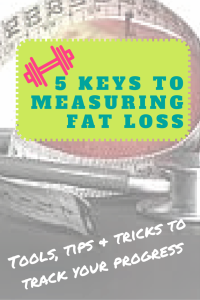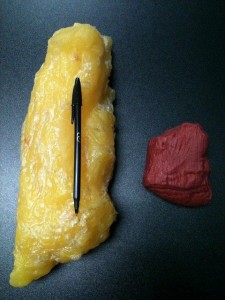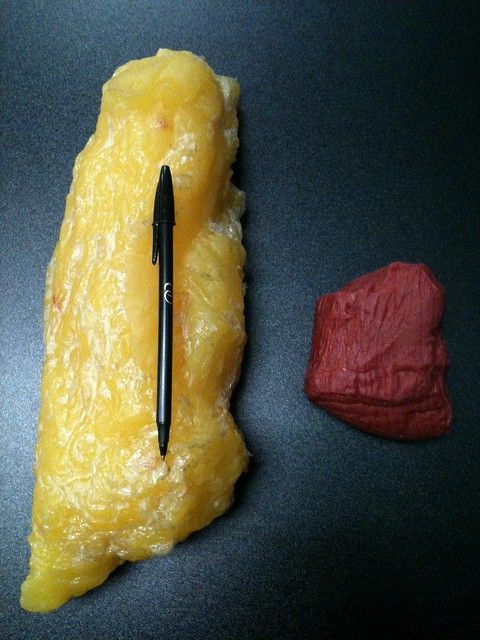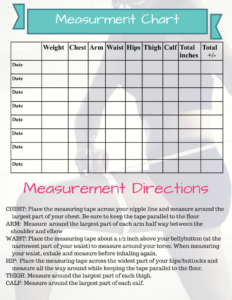So often we hear (or say) the words…”I’ve got to lose some weight”. Weight loss is a billion dollar industry “helping” us to lose those unwanted  pounds. But! we need to ask ourselves….what are those pounds made of? Albeit a little bit gross, consider this:
pounds. But! we need to ask ourselves….what are those pounds made of? Albeit a little bit gross, consider this:
- If we take off our leg, we lose weight.
- When we use the bathroom, we lose weight.
- When we take off our clothes and shoes ( you know you do it at the Dr. office 😉 , we lose weight.
Is this the kind of weight we want to lose to look good, feel great, be stronger and have more stamina? I know it seems somewhat nit picky but we do need to remind ourselves that what we want to lose is fat! Let’s talk in terms of FAT loss.
First off, know that the common phrase “muscle weighs more than fat” is misspoken. A pound of muscle weights a pound and a pound of fat also weighs a pound…profound, I know, but we have probably all caught ourselves making the statement at some point. A more correct statement is that a pound of muscle takes up less space than a pound of fat. It’s true, look:
THAT is eye opening! Now, wouldn’t you much rather lose a pound (or 10) of body fat over a pound of “weight”?
Here are 5 ways to tell if you are losing weight or fat:
- Do not use the BMI (Body Mass Index) scale to determine if you are on target. The BMI scale is VERY outdated but still unfortunately use by many. It is a measurement of height and weight but does not take into consideration what the weight is made up of. I am 5’4″ (almost) and usually weigh 140# with a 16-17% body fat. According to the BMI scale I am 1 point away from being obese…No thanks. If you want a very quick and easy calculator to give you a rough estimate of how you are doing in the body fat realm use this height and weight calculator. This measurement will at least take into consideration a few of the factors that matter. It will still not tell you what that weight is made up of but it will at least get you close so you can know what you are dealing with.
2. Measure fat using a body fat scale. There are a few scales on the market that can do a pretty decent job of estimating body fat if you can get the oh-so accurate hydro static testing done. Hydro static testing (the underwater weighing method) is the most accurate method of testing body fat but it involves holding your breath in a large tank of water. While it is very accurate, it is costly and a bit inconvenient. Here are two body fat scales to try out:
FitBit Aria WiFi Smart Scale – Brand new to the scene Aria tracks yourweight, body fat percentage, and BMI, painting a picture of your long-term progress…and syncs with your FitBit Fitness Tracker
Tanita RD-901 BK Bluetooth Scales with IOS-Smartphone App – Has been on the market for quite some time and always gets great reviews on it’s accuracy. This one is pretty spendy but reported to be reliable even by wrestling coaches. For a little less expensive option Tanita offers the Tanita HD380 Glass Digital Bathroom Scale by Tanita
3. Hip To Waist Ratio:
Measure chest, waist and hips with a good old fashion measuring tape. These are areas where we tend to lose more weight from fat as opposed to building muscle so measuring them is a good indicator as to the kind of weight that is coming off. This can be a quick, simple tool especially when you have a lot of fat to lose.
Measure
For men, a ratio of .90 or less is considered safe.
For women, a ratio of .80 or less is considered safe.
4. Track your measurements:
Choose one day each week to take your measurements to get a better vision of what is really going on. Fridays are a good day because they will give you a good indication of how your hard work is paying off. Over the weekend we tend to loosen up on our eating and my be holding a little extra puffiness from water weight gain due to the consumption of more carbohydrates. For this reason I find that measuring on Fridays helps to ensure better habits over the weekend
You can download the chart to the right HERE
5. Be consistent.
Being consistent with they type of measurement you use can eliminate a lot of frustrations. None of these methods are going to be exactly accurate and there might be some variation if , say, you hold the tape measure in a lightly different spot this week than you did last week, but they are going to give you an idea as to whether your nutrition and exercise are leading you in the right direction. If you bounce from one testing type to another you will get different readings that will not compare accurately with one another.
Remember, one of THE best assessments is how your clothes are fitting and how your muscles feel. Even if the scale is not moving much but your clothes are fitting more loosely, you are most likely losing body fat (refer tot he picture above). You may even be putting on some hard earned muscle which is not causing the scale to move much. This is ABSOLUTELY OK because that new muscle is very metabolically active (burns a lot of calories) and is going to continue to help burn fat. Keep going!


